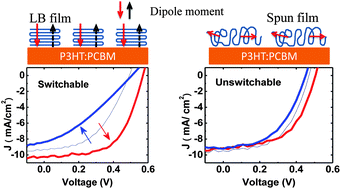It is demonstrated that the power conversion efficiency (PCE) of organic photovoltaic devices can be increased by inserting an ultrathin film of a ferroelectric co-polymer, poly(vinylidenefluoride-trifluoroethylene) (P(VDF-TrFE)), at the metal–organic interface, due to an enhancement of the charge extraction efficiency. Specifically, the effect of P(VDF-TrFE) crystallinity on its function in ferroelectric organic photovoltaic (FE-OPV) devices has been studied by several methods. Highly crystalline and amorphous P(VDF-TrFE) films have been prepared by the Langmuir–Blodgett method and spin-coating from acetone solution, respectively. The polymer solar cell devices with a crystalline P(VDF-TrFE) interfacial layer at the cathode have larger PCE than the structures with amorphous P(VDF-TrFE) and have the unique feature of switchable diode polarity and photovoltaic performance controlled by external applied voltage pulses. The obtained results confirm that the spontaneous polarization of the ferroelectric P(VDF-TrFE) layer is responsible for the enhancement of PCE in FE-OPV devices and that a highly crystalline ferroelectric polymer film is required to observe the enhancement of PCE. Amorphous P(VDF-TrFE) films act as regular dielectric layers with a little poling effect on device PCE. The polarization of P(VDF-TrFE) is shown to be stable, and the photogenerated charges could be collected efficiently by the cathode rather than being compensated.

You have access to this article
 Please wait while we load your content...
Something went wrong. Try again?
Please wait while we load your content...
Something went wrong. Try again?


 Please wait while we load your content...
Please wait while we load your content...